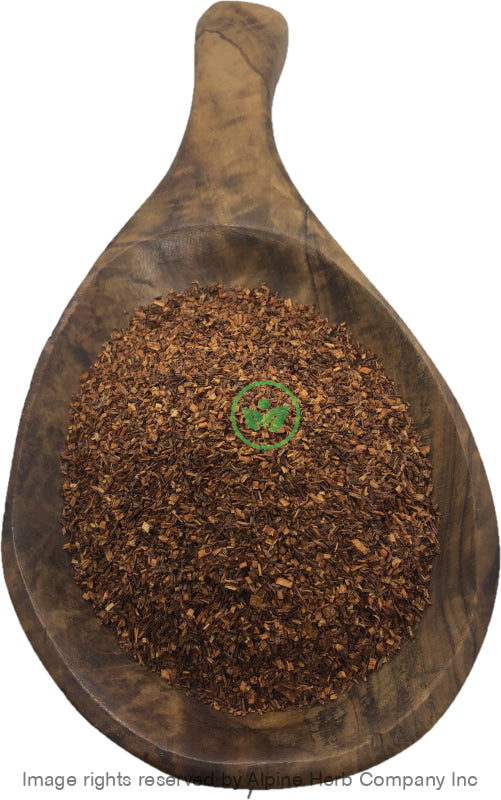Rooibos Tea Cut Alpine Herb Company Inc.
$ 12,49 $ 7,49
Botanical Name: Aspalathus linearis
Common Name:
- English: Rooibos tea, Red bush, Rooibosh
- Also, known as: Rooibos tee, Bossie tee
Habitat: Western Cederberg region of South Africa.
Origin: South Africa
Harvested: Cultivated
Parts Used: Leaves
General Information:
Aspalathus linearis is erect to spreading, highly variable shrub up to 2 m high in its natural state, while the height of cultivated plants varies from 0.5 to 1.5 meters, depending on the age of the plant, as well as the climate and soil conditions in the area of production. Its young branches are often reddish. Near the soil surface, the stem subdivides into a number of strong offshoots, followed by delicate side branches each bearing, singly or in clusters, soft, needle-like leaves. The leaves are green and needle-like, 15-60 mm long and up to about 1 mm thick. They are without stalks and stipules and may be densely clustered. The yellow flowers, which appear in spring to early summer, are solitary or arranged in dense groups at the tips of branches. The fruit is a small lance-shaped pod usually containing one or two hard seeds.
Rooibos leaves are harvested in summer, cut or chopped and are left to ferment. During the fermentation of the rooibos leaves, some chemicals are oxidized by enzymes resulting in the typical red color and flavor of rooibos. Unfermented rooibos tea is also used and contains more antioxidants. Unfermented rooibos tea has a yellow color rather than the red color of fermented rooibos.
Rooibos is grown only in the Cedarberg area and around the villages Clanwilliam and Citrusdal, which are situated to the north of Cape Town in South Africa. Efforts to cultivate rooibos in other areas or countries with similar climates have failed. Apparently, rooibos needs a very specific climate and soil to grow. Rooibos tea has always been very popular in South Africa. To make the popular rooibos tea, the dried rooibos leaves are boiled in water and is often consumed with milk. Rooibos tea is much appreciated because it does not contain caffeine and is low in tannins. This fragrant, caffeine-free tea is the national drink of South Africa. There are a variety of forms and types including, red, black, red-brown and grey rooibos with one of the red types, being the one we’ve come to know and appreciate as our rooibos tea.
How to use:
Hot Infusion:
The basic method for dried herbs and flower is, take 2-3 tablespoons of dried herb in a cup or teapot. Pour hot water over it and cover it with lid for 10-30 minutes. Hot water is needed to draw out the antioxidants, enzymes, vitamins, flavonoids, and volatile oils from the botanicals. Strain and squeeze out as much as liquid as possible and enjoy!
Tips:
- You can sweeten your herbal tea with a bit of honey, natural fruit juice, stevia leaves powder and or licorice root powder.
- You can make ice cubes or pops by freezing tea in ice trays or pop molds.
Precautions:
You should consult with a qualified healthcare practitioner before using any herbal products, particularly if you are pregnant, nursing, or on any medications.
All information on this website is for educational purposes ONLY.
This information has not been evaluated by Health Canada.
This information is not intended to diagnose, treat, cure, or prevent any disease.
| Unit Size | 100g, 200g, 400g, 1kg |
|---|
Prompt shipping and expert packing
Thanks to our longstanding association with UPS FedEx DHL as well as other leading global carriers, we can offer a variety shipping options. Our warehouse staff is highly trained and will be able to pack your goods in accordance with our precise and exact specifications. Your items will go through an exhaustive examination before they will be securely packaged before being delivered. We ship to hundreds of thousands of customers daily in different countries. This is a sign of our determination to become the largest online retailer worldwide. Warehouses and distribution centers are located throughout Europe as well as in the USA.
Note that orders containing multiple items are processed according to the particular item.
We will thoroughly inspect all items ordered before shipping. Most orders are shipped within 48 hours. The delivery time will be between 3 and 7 working days.
Returns
The stock market is always changing. It's not entirely managed by us since we're involved with several entities, including the factory and the storage. Therefore, the actual inventory could fluctuate at any moment. Please be aware that it is possible that your order could be out of stock after you've placed your order.
Our policy lasts for 30 days. If it's been more than 30 days since the date you purchased your item We're sorry to say that we can't offer you a full exchange or refund.
You can only return a product if it is unused and still in the same state as when you received it. The item should be in the original packaging.


































